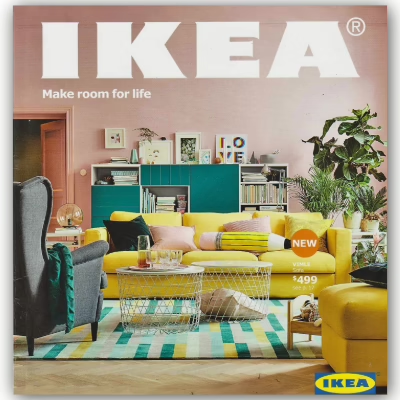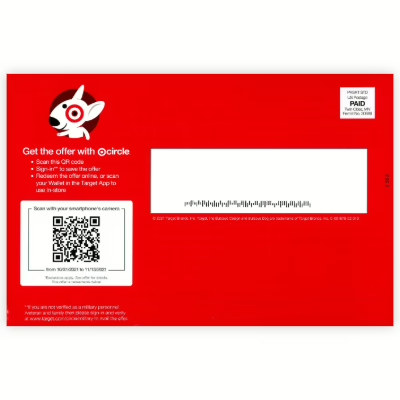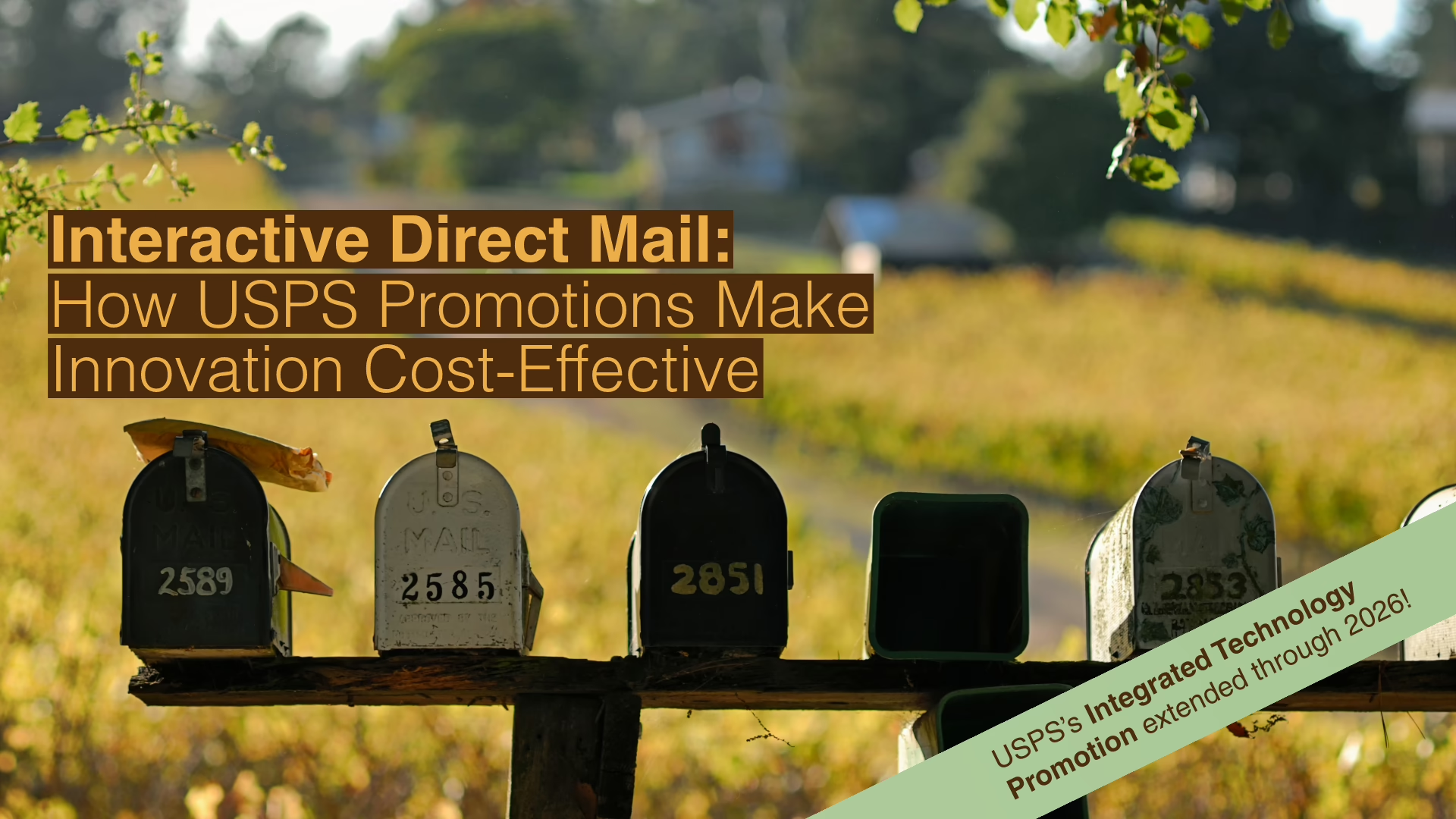Interactive Direct Mail: How USPS Promotions Make Innovation Cost-Effective
There’s no slowing down the speed of technology. As it continues to evolve, traditional communication channels such as the USPS (direct mail ) are finding new ways to adapt and stay relevant.
The current USPS promotional calendar is focused on rewarding marketers who are taking advantage of modern direct mail advancements such as integrated technologies, automated drip and nurturing campaigns, and tactile and sensory elements. There are other ways to save on direct mail campaigns through the USPS, all of which we help you qualify for, but for this article we’re going to be taking a deeper look into some of the ways you can include interactive elements to your mail to not only save on postage but to also improve on your campaign’s performance.
Three Ways Interactive Mailers Boost Performance
- Participation: When someone interacts—scratches, peels, or scans—they’ve invested attention in your piece. That simple action creates stronger recall and response.
- Perceived Value: Interactive features signal exclusivity or reward, making the mailer feel premium.
- Trackability: With PQR codes you can measure exactly how recipients engaged.
Understanding The USPS’s Integrated Technology Promotion
Let’s begin by unpacking what the current Integrated Technology Promotion is and what technologies it includes.
This promotion offers a 3% postage discount to mailers who incorporate advanced digital technologies into their mail pieces. If you’re still wondering why the USPS would offer savings for the inclusion of digital elements, the aim is to bridge the physical and digital worlds—letting brands turn a standard letter or flat into a rich, interactive experience that drives engagement beyond the mailbox.
This promotion will carry into 2026 with an increased savings up to 5%. Registration for 2026 direct mail campaigns begins on November 15, 2025 and will run through December 31, 2026. Just like this year, mailers may select any six-month consecutive period to participate. Another highlight: we manage the qualification and application process for our clients so you don’t have to stress.
Here’s a breakdown of each of the eight technologies and what they mean in practice:
- Augmented Reality: Overlaying digital content (3D models, animations, information) on top of the physical mailer using a smartphone or tablet camera. For example, a recipient scans a code and sees a product pop out of the mail.
- Mixed Reality: A more immersive blend of real and virtual environments, where users may interact with both physical and digital elements simultaneously—typically requiring special hardware or apps.
- Virtual Reality: Fully immersive digital environments accessed via VR headsets or compatible devices, where the recipient may be transported into a wholly virtual space triggered by the mailer.
- Integration with Voice Assistant: Mailpieces that prompt or integrate with voice-activated platforms like Amazon Alexa or Google Assistant. For example: “Say ‘Alexa, start my special offer’” to continue the interaction.
- Near Field Communication (NFC): Using embedded chips or tags in the mail piece that trigger a digital action—tap or hold-device to launch content, landing page, app, or interactive experience.
- Video in Print: Embedding or linking physical mail to video content so that a recipient can watch a video via scanning or interaction with the mailer (e.g., QR code, NFC trigger).
- Mobile Shopping: Incorporating mobile-optimized triggers (like QR codes) that lead the recipient directly from the mailer to a mobile storefront or checkout experience.
- Artificial Intelligence (AI): Using AI tools (for example, generative AI for visuals or copy) in the design or execution of the mailpiece experience. This could include AI-generated images or text that are part of the mail-to-digital journey.
Augmented Reality
One real time example of how augmented reality can work with direct mail is the campaign IKEA ran. It allowed customers to scan pages of their printed catalog with their smartphone or tablet camera, which then let them virtually place furniture in their own living space (via AR).
Takeaway: For AR in a direct-mail promotion, you’d want a mail piece that includes a marker or trigger (QR code, image) that launches the AR content in-app or in-browser.

Mixed Reality
Toyota has integrated mixed reality into its marketing strategy by creating immersive showroom experiences. In Toyota’s MR showroom, customers wear MR headsets that blend the physical showroom with digital overlays. This setup enables users to view 3D models of vehicles, customize features, and receive real-time information about different car models, all while remaining within the physical space of the showroom.
Note, this experience is NOT tied to a direct mail campaign.
Mixed reality requires advanced hardware. Finding a real-life example of a mail campaign that has taken advantage of this technology has proven difficult. However, we can talk through how this could work in a USPS-eligible campaign.
Physical Mail Trigger:
- A postcard, letter, or catalog includes a QR code, NFC tag, or AR marker.
- Copy instructs the recipient: “Scan this code and place your phone near the included marker to customize your dream car.”
The Experience:
Once scanned, the user’s device drops their dream car into surroundings with prompts to customize and stylize as desired. Unlike AR, MR allows users to interact with both physical and virtual elements simultaneously (moving, resizing, or changing features).
Converting:
The mailer can include a CTA for checkout, scheduling, or sharing their MR experience, completing the mail-to-digital loop.
Virtual Reality
In 2017, the United States Postal Service (USPS) partnered with Kelsey Liggett Creative to design an innovative VR direct mail campaign aimed at educating B2B customers about new product offerings. The campaign featured a fictional sporting goods company that sent out cardboard VR headsets to recipients. Upon assembling the headset and inserting a smartphone, users were immersed in a virtual environment showcasing USPS’s capabilities, such as package tracking and delivery services.
Awarded: The campaign received several accolades, including a Webby nomination and a Silver DMA Echo award, highlighting its success in merging traditional mail with innovative technology to deliver a compelling customer experience.

Voice Assisted
An example of voice assisted technology inclusions within direct mail is the 2021 Smith & Noble, a custom window treatment retailer, campaign. The campaign featured a postcard with a call-to-action instructing recipients to “Say ‘Alexa, open Smith & Noble’ to explore our window treatment options.
Upon activating the voice command, Amazon Alexa would launch a custom skill developed by Smith & Noble. This skill provided users with information about various window treatment styles, materials, and options available, effectively transforming the voice assistant into a personalized shopping assistant.
Impact:
DirectMail.io has pioneered the integration of voice assistants like Amazon Alexa and Google Assistant into direct mail campaigns. Their innovations have led to significant campaign engagement, claiming 65% of users who interacted with the voice assistant setting an appointment to learn more about the brand and the offers presented.
Near Field Communication NFC
Finding a direct mail example of NFC technology is another difficult find. However, there are numerous examples of NFC-enabled print campaigns that we can easily see being translated into direct mail campaigns.
Malibu Rum NFC-Enabled Campaign:
300,000 bottles of Malibu Rum were embedded with NFC tags. Consumers who tapped their NFC-enabled smartphones on the bottles gained access to interactive experiences, including games, cocktail recipes, and entry into competitions. This campaign not only increased customer engagement but also boosted sales by providing a direct and interactive marketing channel.
Ralph Lauren NFC Retail Campaign:
Ralph Lauren incorporated NFC technology into their retail marketing by placing NFC-enabled smart posters in stores. Customers could tap their smartphones against these posters to receive immediate access to the latest collections, personalized shopping experiences, and exclusive offers. This strategy aimed to bridge the gap between physical and digital shopping experiences, providing customers with instant and interactive content.
KFC NFC-Enabled Posters:
KFC employed NFC technology in their promotional posters. When consumers tapped the NFC tags on these posters, they were directed to a map showing the location of the nearest KFC restaurants, facilitating easy access to store information and enhancing customer convenience.
Lexus NFC-Enhanced Print Ads:
Luxury car manufacturer Lexus incorporated NFC technology into their print advertisements in Wired magazine. Readers could tap the NFC-enabled ads with their smartphones to access information about the car’s new app suite, enhancing the digital experience and providing immediate access to product details.
Video in Print
Video in print does require a special type of mailer with a programmable video screen. This technology has been available for several years, however, the cost of these special mail pieces has limited their usage. Although the cost continues to be significantly higher than a standard direct mail campaign, these have reduced to be within range for more companies running unique promotions. Here are a few examples of brands who have used this technology in the past.
Baltimore Country Club—Membership Recruitment
Baltimore Country Club incorporated video mailers into their membership recruitment efforts. The videos provided a virtual tour of the club’s facilities and testimonials from current members, offering a personal touch that resonated with potential members.
Biltmore Estate— Luxury Marketing
The Biltmore Estate utilized video mailers to promote their luxury offerings. The mailers featured high-quality videos highlighting the estate’s amenities and experiences, effectively capturing the attention of their affluent clientele.
Community Foundation of Sarasota County— Donor Engagement
The Community Foundation of Sarasota County employed video mailers to engage potential donors. These mailers showcased the foundation’s impact through compelling videos, enhancing the personal connection with recipients and encouraging donations.
Mobile Shopping
One of the most accessible and effective technologies for this promotion is mobile shopping, which leverages mobile-optimized triggers—like QR codes or NFC tags—embedded in direct mail. We’ve all seen—and most likely engaged with—mailers that include QR codes, PQR codes, or NFC tags directing us directly to online shopping experiences or checkout pages.
Now is the perfect season to include mobile shopping capabilities into your direct mail campaigns! As we’re all looking for the perfect something’s for our loved ones, friends, neighbors, and selves, including direct mail utilizing this technology into your Q4 strategy not only unlocks savings, but also guarantees campaign lift.
Target—Circle Rewards Program
Target utilized QR codes in direct mail to promote its Circle Rewards program. Customers could scan the code to access personalized offers and discounts, encouraging immediate shopping actions through their mobile devices. This strategy not only facilitated mobile shopping but also personalized the customer experience.

Sephora—Product Information and Mobile Shopping
Sephora has incorporated QR codes in their direct mail campaigns to provide recipients with instant access to product information and mobile shopping options. Scanning the code directed customers to Sephora’s mobile site, where they could learn more about products and make purchases directly from their smartphones.
Amazon – “Holiday of Play” Catalog
Amazon’s “Holiday of Play” catalog featured branded QR codes called “SmileCodes” on each page. Recipients could scan these codes to access specific product pages on Amazon’s website, streamlining the shopping experience directly from the physical catalog. This initiative effectively bridged the gap between print and digital shopping, enhancing user engagement.
Artificial Intelligence
What AI in Direct Mail Means:
- Generative AI for Visuals: Creating customized images or graphics for mail pieces, tailored to the recipient’s interests or demographic profile.
- AI-Generated Copy: Producing personalized messaging that increases engagement, such as dynamic headlines or calls-to-action.
- Predictive Targeting: Leveraging AI to determine the most relevant content, timing, and design for each recipient, maximizing response rates.
- Integration With Digital Journeys: AI can personalize follow-up digital experiences triggered by the mailer, from mobile shopping pages to video content or email sequences.
We’re working hard on launching our own Ai-powered direct mail software. Stay tuned for Post Scout launching early in 2026.
Final Thoughts
The landscape of direct mail is evolving faster than ever, and the USPS’s Integrated Technology Promotion is a prime example of how traditional mail is embracing innovation. By incorporating technologies such as AR, VR, NFC, video in print, mobile shopping, AI, and even voice assistants, you can transform a simple mail piece into an engaging, interactive experience that drives measurable results.
Interactive mail doesn’t just capture attention—it deepens engagement, enhances perceived value, and creates actionable insights that help optimize campaign performance.
Now is the time to experiment with these tools, integrate them into your campaigns, and take advantage of USPS promotions that reward innovation. As technology continues to blur the lines between physical and digital experiences, the brands that embrace these interactive mail strategies will stand out, drive higher engagement, and ultimately see stronger results.
Comments are closed.


